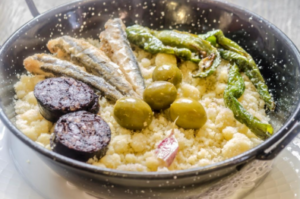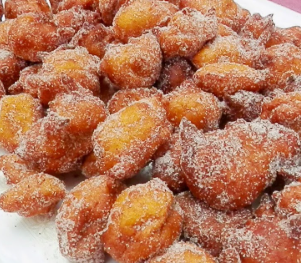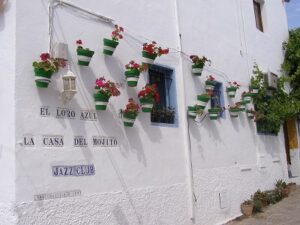When people think of Spanish cuisine, they often picture paella in Valencia or tapas in Seville. But the city of Almería offers a culinary experience that’s refreshingly different — and often overlooked. With its blend of Mediterranean, Moorish, and rural Andalusian influences, Almería’s gastronomy is full of bold flavors, fresh ingredients, and time-honoured traditions.
In fact, Almería was named Gastronomic Capital of Spain in 2019, a title that spotlighted its rich food culture and dedication to sustainable, local produce. Whether you’re a foodie or just love a good meal, here’s what you should eat when visiting this coastal gem.
1. Tapas with a Twist – and They’re Free!
One of the joys of eating in Almería is the free tapa culture. Unlike most of Spain, where you choose from a set menu and pay for tapas, in Almería, you often get to choose your tapa for free with each drink. It’s a local tradition that encourages bar-hopping and slow, sociable eating.
Must-try tapas include:
Chérigan – a slice of toasted bread topped with everything from tuna and alioli to jamón and fried quail egg.
Lomo con tomate – tender pork loin in a rich tomato sauce.
Caracoles – small snails in a spicy broth, often served in spring.
2. Gurullos con Conejo (Rabbit Stew with Homemade Pasta)
This hearty, traditional dish hails from Almería’s mountainous interior. Gurullos are small, hand-rolled pieces of dough, a bit like broken pasta, cooked in a rich stew with rabbit, garlic, peppers, and paprika. It’s rural Andalusian comfort food at its best — rustic, filling, and packed with flavour.
3. Migas Almerienses
 Unlike the breadcrumb-based migas of other regions, Almería’s version is made with semolina or flour and sautéed in olive oil with garlic. It’s usually served with fried sardines, chorizo, green peppers, and even grapes. Traditionally eaten on rainy days, it’s now a beloved dish at local celebrations and family gatherings.
Unlike the breadcrumb-based migas of other regions, Almería’s version is made with semolina or flour and sautéed in olive oil with garlic. It’s usually served with fried sardines, chorizo, green peppers, and even grapes. Traditionally eaten on rainy days, it’s now a beloved dish at local celebrations and family gatherings.
4. Olla de Trigo (Wheat Stew)
A lesser-known winter dish, olla de trigo is a slow-cooked stew of whole wheat grains, pork, beans, and vegetables. Earthy and nutritious, it reflects the region’s agricultural roots and is a favourite in inland villages.
5. Tabernero
 Not to be confused with a bartender, tabernero is a warm tapa made from slow-cooked vegetables — usually tomato, onion, and green pepper — mixed with minced meat and served on bread. Simple and satisfying, it’s a staple in many tapas bars.
Not to be confused with a bartender, tabernero is a warm tapa made from slow-cooked vegetables — usually tomato, onion, and green pepper — mixed with minced meat and served on bread. Simple and satisfying, it’s a staple in many tapas bars.
6. Gambas Rojas de Almería (Red Prawns)
Caught off the nearby coast, these sweet, juicy red prawns are a luxury well worth trying. Often simply grilled with sea salt or served in garlic oil, they’re a local delicacy that showcases the region’s marine bounty.
7. Escabeche Dishes (Marinated Fish or Meats)
This Moorish-influenced method of marinating fish or meats in vinegar, olive oil, and spices is still popular in Almería. Look out for partridge in escabeche or mackerel — both are deliciously tangy and refreshing, especially in summer.
8. Papaviejos (Local Dessert)
 A traditional sweet made from flour, eggs, milk, sugar, and orange zest, fried and sprinkled with cinnamon or soaked in syrup. This humble dessert often appears around Easter, but you’ll find it in local bakeries year-round.
A traditional sweet made from flour, eggs, milk, sugar, and orange zest, fried and sprinkled with cinnamon or soaked in syrup. This humble dessert often appears around Easter, but you’ll find it in local bakeries year-round.
9. Tarta de la Abuela (Grandma’s Cake)
A creamy layered cake made with biscuits, custard, and chocolate, often found on menus in traditional restaurants. It’s a nostalgic favourite that locals associate with family meals and celebrations.
10. Local Wines and Craft Beers
Almería’s dry climate and rugged terrain may seem unlikely for wine, but the province has seen a boom in small-scale wineries producing bold reds and crisp whites — especially around the Alpujarra region. Also, don’t miss local craft beer brands like Cervezas Far West or Alborán, often found in hip city bars.
Related articles

Top 10 must visit places in Almeria
Almería, located on the southeastern coast of Spain, is a hidden gem that combines a rich history with stunning natural

Day trips from the city of Almeria
The towns and villages surrounding Almeria are some of the most picturesque in Spain and provide a wide range of

Lesser known places to visit in the city of Almeria
Almería is a city that often slips under the radar of tourists chasing the big names of Andalusia. But for

Traditional Fiestas in Almería
Throughout the year, towns and villages across the province of Almeria burst into colour, music, and joy during their traditional
